|
After
some nifty, Saul Bass inspired checkerboard credits,
accompanied by a
rousing Gerard Schurman score, our movie
proper begins in glorious SpectaMation
with
a small plane flying over the
jungles of Africa. And judging by the engine's
constant burping fit, the aircraft appears
to be in some
serious trouble -- and that's confirmed
when the
plane quickly goes into a terminal
nosedive and explodes on impact.
And
judging by the size of the explosion and
fireball, the plane was carrying a load of paint thinner,
kerosene, dynamite, and several cases of
Mercury Fulminate!
Cut
to London's Piccadilly Circus, where a
newsie informs us that famed botanist, Dr.
Charles Decker, was lost in that tragic plane
crash -- but then we
immediately time-warp to one year later
and watch the same newsie (--
and the same costumers, including the
film's producer,
Herman Cohen --), who tells us that not
only did Decker survive the crash, but
after spending a year in the jungle, he is
returning home to London that very day.
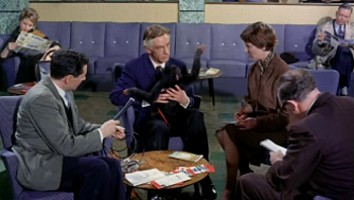
At
an impromptu news conference, Dr. Decker
(Michael
Gough) reveals he also brought a
friend back with him; a baby chimpanzee
heís dubbed Konga. When a reporter asks
if he feels fortunate to be back in
civilization, we get the first inkling of
Deckerís all-encompassing smugness and
pompous douche-itude when he answers
"It
depends on what you call
civilization." Claiming the air
disaster was a lucky break (--
and I'll bet the pilot has a different
opinion on that), the marooned Decker made
friends with the natives and spent the
year studying rare plants with "animal
tendencies." As Decker continues,
he claims his new discoveries will also
rewrite a few textbooks but refuses to go
into specifics -- except for a tantalizing
and incendiary tidbit about finding the evolutionary link
between plants and man!
[Heston/]
"A planet
where men evolved from plants? Get your
stinking leaves off me you damn dirty
lilacs!" [/Heston].
Returning to his palatial
estate, Decker finds his house
and lab in perfect order, thanks to his
loyal assistant, Margaret (Margo
Johns); although I think
she wants to be a little more than just
his assistant (-- if you know what I
mean), and who is a little perturbed
when Decker seems more concerned about the
arrangements made for Konga instead of
being happy to see her. (See what I
mean?) But the doctor calms her, saying his discoveries might soon
make them the rulers of the Earth. His
excitement proves contagious and, wanting
to start his new experiments right away, they
place little Konga in his suspiciously
spacious cage -- a cage a concerned Decker fears might
still not be large enough. (Uh-oh.)

Moving on to the greenhouse, as Decker starts
tearing up all his old flowers to make room
for the plants heís brought back from
Africa, his maniacal behavior is
beginning to frighten Margaret a little,
who begs him to slow down and get some
rest. Somewhat surprisingly, he agrees and
they call it a night.
Early
the next morning, Margaret finds the
doctor already hard at work in the lab.
Apparently, while he was in Africa, Decker
observed the rituals of a witch doctor,
whose experiments with the
extracts of several carnivorous plant had
some amazing results on his test subjects:
seems the injected animals grew and
matured at an amazing rate.
Also of note, the native doctor had
some "seeds of obedience"
that allowed him to control his
experiments. (And at this point we
wonder if Decker might have been out in
the sun a little too long.) Not surprisingly,
Margaret
doesnít believe his wild tale -- until
his boiling plant extract bubbles over onto the
floor, where the family cat pounces and
begins to lap it up. Horrified, Decker
rummages for a revolver and shoots the
animal dead. Now Margaret is the one
horrified as he explains,
in all seriousness, that the world
isnít ready for a cat the size of
leopard running loose in London.
(Oh, I donít know ... Hainesville
got along alright.) No.
Not a giant feline. You
see, Decker
wants Konga to be the inaugural test-subject
of his rather dubious and diabolical
accelerated growth experiments...
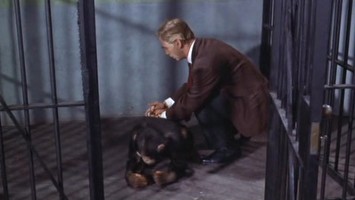
Thankfully,
our Mad Mammoth Monkey Marathon shakes off the
rough start of King
of Kong Island by picking up some
much needed momentum in the Isle of Britain.
(Blimey!)
And if nothing else, at
least this one has a giant monkey in this
one! Hurray!
Anyways,
when independent producer Herman Cohen put
together a string of modest money-making
B-pictures for United Artists, the
filmmaking wunderkind, barely in his
twenties, got the studio's backing for his
inaugural A-Picture, Crimes of Passion.
But despite the combined star-power of
Sterling Hayden and Barbara Stanwyck, the
steamy film-noir never found an audience,
and suddenly, United Artists was no longer
taking any of Cohen's calls. Needing a
quick turnaround, when Cohen's old buddy
Jim Nicholson called, wanting him to do a
picture for his fledgling American
International Pictures, the producer
dusted off an old idea about a teenaged
wolfman and his stock was soon on the
rise again when I Was a Teenage
Werewolf hit and hit big, triggering a
profitable but somewhat tumultuous
relationship with AIP over the next
several years.
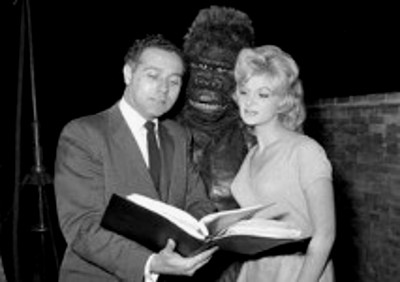
It
was during his days with United Artists
that Cohen first went into business
on a mutual distribution deal with
Nat Cohen's England based
Anglo-Amalgamated
(--
and for the record, the men were not
related); and after wringing the
teen-angst fueled monster niche to within
an inch of its life, Cohen was ready to
try something else and
struck another deal with A-A and American
International to co-finance a color
feature, The Horrors of the Black
Museum; a murder mystery based on
Scotland Yard's nefarious collection of
dastardly criminal contraband -- yeah, the
one where the lady with the tricked-out
binoculars gets impaled through the eyes
-- which proved such a big hit a
follow up was soon put on the fast-track.
As both a fan of the original King Kong
and gorillas movies in general, Cohen
turned to his long time writing partner,
Aben Kandel, and collaborated on Konga,
-- a tale about a giant ape trashing
London, with a little mad maniacal science
thrown in, free of charge. The producer
even went so far as to pay a cash-strapped
RKO in advance
as to not get sued for plagiarism; and
also secured the rights to use King
Kong in all the advertising
materials. Was the FURY and SPECTACLE of
Cohen's Konga a worthy successor to
Merian C. Cooper's Kong?
Well, yes and no.
But mostly no. Stick with me, here, and
all will be explained as we
now rejoin our review after several
weeks have passed and the monster plants in
Decker's greenhouse have finally reach
maturity. Most
resemble giant Venus flytraps, while
others resemble a cobra, ready to strike, complete with
flicking tongue! After some
pruning, Decker takes
the leafs back to the lab, where he distils
them into a liquid. Then Margaret watches
as Decker injects the extract into Konga,
causing the baby chimp to quickly grow to
adult size. With this success, Deckerís
manic glee at this point is almost
palpable.
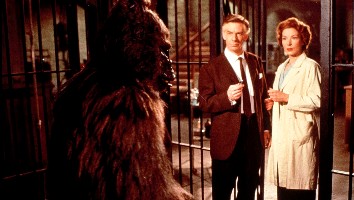
This
growing sequence is accomplished by
matte-effect, with the screen going all
psycho-wavy as the monkey grows larger.
I've affectionately dubbed this the Dramamine
Effect.
But
further experiments will have to wait.
Remember, Decker is a Professor of botany
and must resume his teaching responsibilities at the University. When
his current class ends, we meet his prize pupil,
Sondra (Claire
Gordon). Ogling the full-figured
girl rather lecherously, Decker comments
on how much sheís *ahem* matured
while he was away. Though the girl seems
genuinely interested in the new
discoveries heís alluded to,
unfortunately, he only appears interested in
what's underneath that very tight sweater.
(The creep.) Promising her fortune
and glory if she becomes his special
assistant, Sondra agrees -- much to the
dismay of her boyfriend, Bob (Jess
Conrad).
Later, Decker is summoned
to a meeting with Dean Foster (Austin
Trevor), who is none
too happy about those wild claims about
plant evolution Decker has been
feeding the newspapers. Believing these
notions to be utter nonsense, and that it
reflects badly on the college, their
conversation quickly turns ugly; and
then Foster signs his own death warrant
when he proclaims that as long he's the
boss, Decker will do as he says -- or
else. (Poor
guy, ainít he ever seen one of these
B-movie potboilers?) Returning
home, a livid Decker finds Margaret
teaching Konga a few parlor tricks. Asked
to be left alone, Decker gives the chimp
another injection, and after Konga grows to
about the size of a George Barrows, the mad doctor
uses a penlight to hypnotize
the ape to do his bidding ( --
leaving that "seeds of
obedience" thread to wither and die
on the vine). That night, an enthralled
Konga breaks into Fosterís office and
kills him.
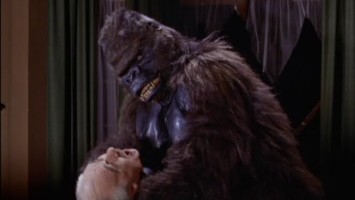
The
next morning, the Scotland Yard inspectors assigned to the case are baffled by the homicide.
All the evidence says a large primate
killed the victim but the zoo has reported
no
animals running loose, leaving them
stumped. Meanwhile,
Decker is strangely unaffected by the
headlines proclaiming Fosterís brutal death.
But Margaret isn't stupid; she knows he had Konga kill him. Decker doesn't deny
this, claiming itís all part of his grand
experiment to test Kongaís obedience,
and then compares
Foster's death to all the lab rats killed
in scientific experiments; all worth it
for the advancement of knowledge, right? (Wow,
this guy is cold.) When
this ruthless logic pushes Margaret's
blind devotion past even her limits, he
turns the tables on her by pointing out
that, technically, sheís an accessory to
Foster's murder. Knowing that's a bit of
stretch, and fearing she might still crack, Decker promises to marry
Margaret if
sheíll keep quiet. (A
similar tactic used by Whit Bissel in
Cohen's I
Was A Teenage Frankenstein.
And someone should probably point out to
Margaret how that turned out...)
After
Fosterís secretary comes forward and
recounts the heated argument her boss had with Decker on the day he was
murdered, when the inspectors interrogate
him, their new suspect keeps his cool, saying
the argument was purely over philosophical
differences and that's all there was to
it. And besides, he is a man of science --
and scientists donít resort to violence;
they just talk things out ... Later, at a
faculty gathering, a visiting professor
corners Decker. Seems Dr. Tagore (George
Pastell) has read about his rivals theories on plant extracts to accelerate
growth in animals. And since he, too, has
experimented along the same lines with the
same startling results, Tagore is about to
go public with his discoveries. (Thus
stealing Deckerís thunder.)
Asking if they might join forces and
pursue the research together, Decker is
flatly turned down; Tagore has all the proof he
needs and has no desire to share the spotlight. (So we know he wonít
be around much longer, either.)
Mental wheels
spinning, Decker coyly asks if he might
see his rival's results. They agree to
meet in Tagoreís lab later, but when
Decker arrives to talk things out, he isnít
alone. And while Konga strangles the other
scientist, Decker confiscates his notes
and taunts the dying Tagore that heís
earned the right to all the glory of these
growth experiments. He then orders Konga
to destroy the lab, leaving no evidence of
Tagoreís experiments in one piece.
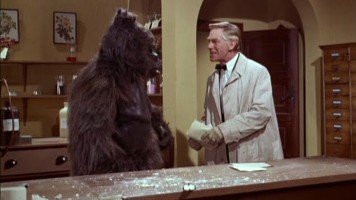
A
few days later, as Deckerís class piles
into a van for a field trip, he tells
Sondra to ride in front with him. In the
back, the other students rib Bob constantly
about all the attention the new teacherís
pet has been getting. When they reach the
forest and scatter to collect some ferns, Bob
manages to get Decker alone and warns him to leave
Sondra alone. Of course, with
Decker being Decker, things soon come to
blows. The younger Bob quickly gets the upper
hand, catching the older man in a deadly
stranglehold, but manages to come to his
senses before it's too
late. Begged for forgiveness, Decker makes
the boy promise if he can keep his
emotions under control, before he kills
someone, Decker will tell no one about the
incident. But later that evening, on
his way to apologize to Sondra, Bob says
goodbye to his family for the last time --
and
doesnít even get out of the front yard
before Konga strikes!
As
the bodies keep piling up, the police
arenít any closer to nabbing the
killer. Convinced that all three murders
are related, they canít find a common
motive. Throwing a canvas over the school,
they question everyone and also recheck
the zoos and every private monkey owner in
London. Reading all of this in the
dailies, Margaret scolds Decker for
killing the boy, who say why
he killed him. Besides, Decker says,
technically, he didnít kill him -- Konga
did. Accused of hiding behind
technicalities, he counters with some Nietzchien
B.S. about his experiments being beyond
normal comprehension. (The
man is smuggest S.O.B.) However,
he does think it's time to destroy Konga
and start over before theyíre caught. He
also wants to return to Africa and
continue his experiments there; but they
canít leave right away, or theyíll
rouse suspicion. Besides, there are a few
other experiments that need concluding
before they go -- namely getting into
Sondra's panties
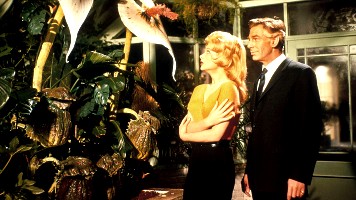
Inviting
the girl over for supper, while they eat,
Margaret is beginning to feel like a third
wheel. And when Decker offers to show
Sondra his giant plant collection in the
greenhouse, Margaret is left behind to do
the dishes -- but secretly follows them
instead. Sondra is fascinated by the meat-eating plants, and Decker promises her
more scientific wonders if she will only come to Africa with him
and be his new assistant. When she isnít
sure, he tries to convince the girl by
assaulting her (--
rather clumsily), in an attempt to
steal a kiss. She rejects him wholesale
but the assault continues. Observing all
of this, Margaret has
seen enough and heads to the lab.
Using the penlight, she re-hypnotizes Konga
to obey her, and then gives the ape
another injection. With that, Konga goes
through another growth spurt and becomes
larger -- a lot larger. Maybe too
large. For as Margaret tries to order him
around, the confused Konga goes berserk
and kills her. (Well,
he kills a doll that kind of looks like
her.) He also appears to still be
growing as he trashes the lab and
accidentally sets it on fire. To escape
the flames, the ape busts his way outside.
Meanwhile,
back in the greenhouse --
seemingly unable to hear a fifty-foot
gorilla destroy his house a few feet away,
Decker is still trying to have his way
with Sondra. From above, Konga jealously
watches them through the skylight before
breaking in and seizing Decker (--
well, a doll that kind of looks like
Decker), and knocking Sondra into
the mutant plants, who when last seen was
up to her armpit in a giant Venus flytrap!
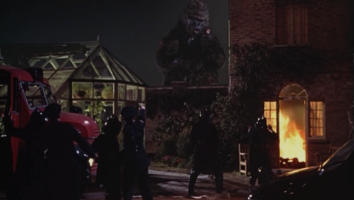
When the fire brigade shows up, they spy
Konga with Decker clasped in his paw, who
orders his experiment gone awry to put him
down. But Konga isn't listening anymore and proceeds to
rampage his way into London proper.
Obviously, the giant ape is
too much to handle for the local police,
who call in the army. Surrounding the
beast near Big Ben, and even though heís
still holding onto Decker, the order to
open fire is given. And as the night lights up
with tracers and the roar of machinegun
fire, Konga is hit and wounded
badly. And since the only weapon he has is
Decker, the ape throws him at his
attackers. Alas, a mad scientist doesn't
make for a good or sturdy projectile and
is killed on impact. Meanwhile, the
soldiers keeps on firing until the giant
ape collapses. (But
according to the tracers, I donít think
they ever actually hit him.) Before
he dies, Konga reverts back to his
original form, and as Big Ben strikes
midnight on our monkey, and Schurman's
syrupy score crescendos and slowly fades
away, everyone gathered
looks around solemnly.
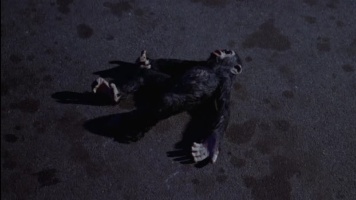
D'aaaawwwwww,
poor little monkey.
The
End
Konga
is surprisingly pretty good until itís, for a
lack of better word, silly slam-bang
conclusion. The ending isnít terrible,
mind you, it just isnít executed very well and
spoils a pretty decent set-up. But damn it
all if it isnít freakin' hilarious.
It
took almost a year and half, and one near,
catastrophic International incident on the
last day of filming, to get Cohen's film
into theaters -- and most of that time was
spent trying to get the F/X in the can,
which runs the gambit from the wonderfully mediocre to
the hysterically
inept. Those killer plants in the
greenhouse were farmed out to Hammer
studios' prop department and are a real kick to behold (--
and
we never do find out what happened to poor
Sondra). As for our furry star attraction,
originally, Cohen had slated Steve
Calvert to play Konga, who had played apes
for both his Bride of the
Gorilla and Bela Lugosi Meets the
Brooklyn Gorilla. But Calvert had
retired by 1960, so Cohen turned to
veteran gorilla man, George Barrows.
However, it was cheaper to just ship the
costume over to England than the actor, so
Cohen rented the suit and filled it with
an actor named Paul Stockton. Stockton's suit-inexperience
kinda shows, and I understand
Barrows wasn't real thrilled with the
battered condition of his suit when it was returned
after the film was completed. Now, the
miniature
sets that Stockton got to trash were
really quite good, so kudos to art
director Wilfred Arnold, but the problem
was trying to matte all that mayhem into
one master shot. And though Victor
Marguetti and Rank Labs tried their
darnedest, and made some innovative
headway with a new traveling-matte
technique using yellow sodium lights,
there are just too many shots of a static
Konga, standing too stiffly and too erect, holding
onto Decker that brings the action to a
screeching halt. And as silly as those scenes
are,
they pale in comparison to the scenes
where Konga holds the all too obvious Barbie and Ken
dolls.
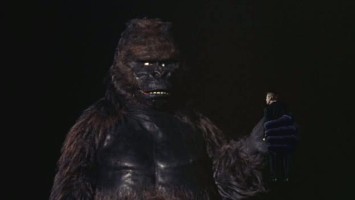
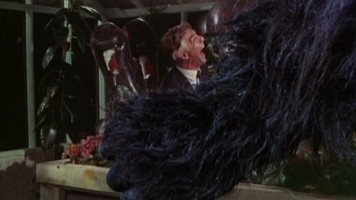
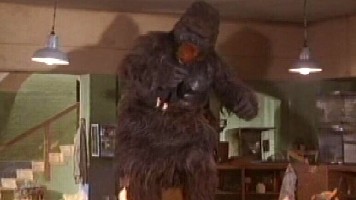
As
for that International incident, seems
that on the day of shooting the climactic
fight scenes in the streets of London,
Cohen had been warned the
authorities-that-be would never allow a
night shoot with all that military
hardware popping off. But after bribing
the local constabulary -- without telling
them what they really intended to do, and
with a quick escape plan ready to be
executed to evacuate the cast and crew at
the first sign of trouble -- the order to
open fire was given and the cameras
rolled. Well, they got the shots they
needed but many Londoners were a little
cheesed by all the noise and thought The
Blitz was back on, and so, Cohen spent the
next few days charming several old ladies,
who threatened to bring suit, with flowers
and chocolates.
Before
I wrap this up, mention of a positive
nature should be made for our
main players. To me, Michael
Gough was born to play dastardly screen villains and
is just great as the mad scientist in this
piece. And matching him toe to toe is his
scheming assistant, played wonderfully by
Margo Johns. A quick check of her credits
proves this was danged near her only
feature film role, which is kinda
disappointing. She's that good. Gough,
meanwhile, played a similar
misanthrope in The Horrors of the Black
Museum, and Cohen kept featuring him
in the likes of Black Zoo, Berserk!
and Trog. It should also be noted
that Konga
was turned into one of those seamy novelizations
put out by Monarch Books, who also adapted
Gorgo
and Brides
of Dracula,
but the most notorious one, of course, was
for Sid Pink's Reptilicus,
with the infamous line "He took her
with his savage lance of manhood."
(I
donít remember any savage lancing in
that movie? Do you?)
All
in all, Konga
might not be very good but it makes for good entertainment. Itís got
everything a mad scientist movie needs: a truly loony
kook of a mad
doctor; man-eating plants; seedy experiments with icky side-effects
that go horribly, horribly wrong; and said
horribly gone wrong experiment that break loose and
run amok. And, of course, the
evil mad scientist eventually gets hoisted with his
own patootie in the end. What more could
you ask for?
|